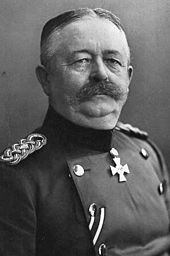XXXX. Reserve Corps (German Empire)
The XXXX. Reserve Corps was a major unit of the army of the German Empire in the First World War .
structure
At the beginning of the war, the corps was formed from Prussian volunteers and was structured as follows:
-
79th Reserve Infantry Brigade
- Reserve Infantry Regiment No. 261
- Reserve Infantry Regiment No. 262
- Reserve Infantry Regiment No. 263
- Reserve cyclist company No. 79
- Reserve Cavalry Division No. 79
-
79th Reserve Field Artillery Brigade
- Reserve Field Artillery Regiment No. 63
- Reserve Field Artillery Regiment No. 64
- Reserve Engineer Company No. 81
-
80th Reserve Infantry Brigade
- Reserve Infantry Regiment No. 264
- Reserve Infantry Regiment No. 265
- Reserve Infantry Regiment No. 266
- Reserve cyclist company No. 80
- Reserve Cavalry Division No. 80
-
80th Reserve Field Artillery Brigade
- Reserve Field Artillery Regiment No. 65
- Reserve Field Artillery Regiment No. 66
- Reserve Engineer Company No. 82
- Reserve Engineer Company No. 83
Corps troops
history
The Infantry General Karl Litzmann was born on December 24, 1914 the first commander of the mobilization established Reserve Corps, the first at the Eastern Front in the 8th Army during the Second Battle of the Masurian Lakes was used. The corps attacked with the 79th and 80th Reserve Divisions, supported by the 3rd Cavalry Brigade, through the Johannisburger Heide against the Gehsen - Wrobeln - Snopken line . On February 7, 1915, the Litzmann group reached the Drygallen – Rollken line. After the complete reconquest of East Prussia , General Litzmann pushed the XXXX. Reserve Corps south of the Nyemen . Between August 14 and 18, 1915, the Kovno fortress, which was considered impregnable, was conquered by skillful command of the troops.
In March 1916, during the Battle of Lake Naroch, the General Command of the 10th Army was subordinate to the right wing. The 79th Reserve Division and the 14th and 16th Landwehr Divisions , which were also subordinate to them, were in the front in the Smorgon area and were not directly affected by the Russian onslaught. Parts of the 80th Reserve Division, which were in reserve, could thus be transferred to the Hutier Corps Group, which was struggling to the north, to Postawy.
In December 1916, the corps was transferred to the Western Front , followed by fighting and the like. a. in Artois and before Verdun . Between July 24 and December 15, 1917, the General Command, which had left the Eastern Front, took over command in the Stanislau area as the Litzmann group in the section of the Austro-Hungarian 3rd Army during the Kerensky Offensive . In the middle of December 1917, the general command took over the leadership in the Slonim area until the beginning of January 1918 .
At the end of January 1918, the corps relocated to the Western Front twice and on February 6, took over the leadership of the Souchez group in the Arras area . At the beginning of April 1918, the corps relocated to Flanders took part in the battle of the Lys , with the 207th and 220th divisions under their command covering the left wing of the 6th Army in the area south of La Bassée . On August 6, 1918, Lieutenant General Paul Grünert took command of the corps. At that time it formed the left wing of the 6th Army near Lens . From there it went back to the Antwerp-Maas position until the armistice came about. Grünert led his corps back home and submitted his resignation after the demobilization of the large association.
Commanding general
| Rank | Surname | date |
|---|---|---|
| General of the Infantry | Karl Litzmann | December 24, 1914 to August 6, 1918 |
| Lieutenant General | Paul Grünert | August 6, 1918 until the end of the war |
literature
- Heinz Kraft: Litzmann, Karl. In: New German Biography (NDB). Volume 14, Duncker & Humblot, Berlin 1985, ISBN 3-428-00195-8 , p. 715 f. ( Digitized version ).
Individual evidence
- ^ Reichsarchiv: The World War 1914-1918, Volume VII, Supplements No. 11 and. 12.
- ^ Reichsarchiv: The World War 1914–1918, Volume X. Supplements - Sketch 24.
- ↑ a b Dermot Bradley (Ed.), Günter Wegner: Occupation of the German Army 1815-1939 Volume 1: The higher command posts 1815-1939 , Biblio Verlag, Osnabrück 1990, ISBN 3-7648-1780-1
